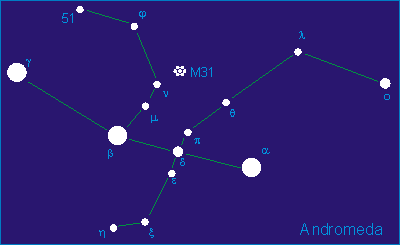Zeta Andromedae
| Observation data Epoch J2000.0 Equinox J2000.0 (ICRS) | |
|---|---|
| Constellation | Andromeda |
| Right ascension | 00h 47m 20.32547s[1] |
| Declination | +24° 16′ 01.8408″[1] |
| Apparent magnitude (V) | 3.92 to 4.14[2] |
| Characteristics | |
| Spectral type | K1III + KV[3] |
| U−B color index | +0.90[4] |
| B−V color index | +1.12[4] |
| R−I color index | +0.59[4] |
| Variable type | ELL/RS[2] |
| Astrometry | |
| Radial velocity (Rv) | −24.43 ± 0.1[5] km/s |
| Proper motion (μ) | RA: −101.17[1] mas/yr Dec.: −81.77[1] mas/yr |
| Parallax (π) | 17.24 ± 0.26[1] mas |
| Distance | 189 ± 3 ly (58.0 ± 0.9 pc) |
| Absolute magnitude (MV) | +0.14[3] |
| Orbit | |
| Period (P) | 17.769426 |
| Semi-major axis (a) | 2.7 R* |
| Eccentricity (e) | 0.0 |
| Inclination (i) | 65 ± 5° |
| Details | |
| A | |
| Mass | 2.6 ± 0.4[3] M☉ |
| Radius | 15.9 ± 0.8[6] R☉ |
| Luminosity | 95.5[3] L☉ |
| Surface gravity (log g) | 2.8[3] cgs |
| Temperature | 4,665 ± 140[6] K |
| Metallicity [Fe/H] | −0.30[3] dex |
| Rotation | 17.77 days[7] |
| Rotational velocity (v sin i) | 41.4 ± 0.2[3] km/s |
| B | |
| Mass | 0.75[3] M☉ |
| Other designations | |
| Database references | |
| SIMBAD | data |
Coordinates: ![]() 00h 47m 20.3254s, +24° 16′ 01.841″
00h 47m 20.3254s, +24° 16′ 01.841″
Zeta Andromedae (Zeta And, ζ Andromedae, ζ And) is a star system in the constellation Andromeda. It is approximately 189 light years from Earth.
Zeta Andromedae is a spectroscopic binary whose primary is classified as an orange K-type giant with a mean apparent magnitude of +4.08. In addition to brightness variation due to the ellipsoidal shape of the giant primary star, the system is also an RS Canum Venaticorum type variable star. Its brightness varies from magnitude +3.92 to +4.14 with a period of 17.77 days. The orbital period of the binary is 17.77 days.
Location
This star's location in the constellation Andromeda can be seen in the following diagram:

Components
A number of visual companions to the eclipsing binary have been observed. B has common proper motion with A, but C and D are probably only line-of-sight companions that have no physical association.[4]
| Multiple/double star designation: WDS 00473+2416[8] | ||||||||
|---|---|---|---|---|---|---|---|---|
| Component | Primary | Right ascension (α) Equinox J2000.0 | Declination (δ) Equinox J2000.0 | Epoch of observed separation | Angular distance from primary | Position angle (relative to primary) | Apparent magnitude (V) | Database reference |
| B | A | 00h 47m 20.2s | +24° 16′ 33″[9] | 1959 | 32.6″ | 0° | 15.3 | Simbad |
| C | A | 00h 47m 15.2s | +24° 15′ 03″[10] | 1997 | 97.0″ | 231° | 13.6 | Simbad |
| D | A | 00h 47m 08.9990s | +24° 15′ 33.584″[11] | 2006 | 155.5″ | 260° | 10.80 | Simbad |
Naming
In Chinese, 奎宿 (Kuí Sù), meaning Legs (asterism), refers to an asterism consisting of ζ Andromedae, η Andromedae, 65 Piscium, ε Andromedae, δ Andromedae, π Andromedae, ν Andromedae, μ Andromedae, β Andromedae, σ Piscium, τ Piscium, 91 Piscium, υ Piscium, φ Piscium, χ Piscium and ψ¹ Piscium. Consequently, ζ Andromedae itself is known as 奎宿二 (Kuí Sù èr, English: the Second Star of Legs.)[12]
References
- 1 2 3 4 5 Van Leeuwen, F. (2007). "Validation of the new Hipparcos reduction". Astronomy and Astrophysics. 474 (2): 653. Bibcode:2007A&A...474..653V. doi:10.1051/0004-6361:20078357.
- 1 2 zet And, database entry, The combined table of GCVS Vols I-III and NL 67-78 with improved coordinates, General Catalogue of Variable Stars, Sternberg Astronomical Institute, Moscow, Russia. Accessed on line August 29, 2008.
- 1 2 3 4 5 6 7 8 Kővári, Zs.; Bartus, J.; Strassmeier, K. G.; Oláh, K.; Weber, M.; Rice, J. B.; Washuettl, A. (2007). "Doppler imaging of stellar surface structure. XXIII. The ellipsoidal K giant binary ζ Andromedae". Astronomy and Astrophysics. 463 (3): 1071. Bibcode:2007A&A...463.1071K. doi:10.1051/0004-6361:20065982.
- 1 2 3 4 HR 215, database entry, The Bright Star Catalogue, 5th Revised Ed. (Preliminary Version), D. Hoffleit and W. H. Warren, Jr., CDS ID V/50. Accessed on line August 29, 2008.
- ↑ Karataş, Y.; Bilir, S.; Eker, Z.; Demircan, O. (2004). "Kinematics of chromospherically active binaries and evidence of an orbital period decrease in binary evolution". Monthly Notices of the Royal Astronomical Society. 349 (3): 1069. arXiv:astro-ph/0404219
 . Bibcode:2004MNRAS.349.1069K. doi:10.1111/j.1365-2966.2004.07588.x.
. Bibcode:2004MNRAS.349.1069K. doi:10.1111/j.1365-2966.2004.07588.x. - 1 2 Korhonen, H.; Wittkowski, M.; Kovári, Zs.; Granzer, Th.; Hackman, T.; Strassmeier, K. G. (2010). "Ellipsoidal primary of the RS CVn binary ζ Andromedae . Investigation using high-resolution spectroscopy and optical interferometry". Astronomy and Astrophysics. 515: A14. arXiv:1002.4201
 . Bibcode:2010A&A...515A..14K. doi:10.1051/0004-6361/200913736.
. Bibcode:2010A&A...515A..14K. doi:10.1051/0004-6361/200913736. - ↑ Strassmeier, Klaus G. (September 2009), "Starspots", The Astronomy and Astrophysics Review, 17 (3): 251–308, Bibcode:2009A&ARv..17..251S, doi:10.1007/s00159-009-0020-6
- ↑ Entry 00473+2416, The Washington Double Star Catalog Archived April 12, 2008, at the Wayback Machine., United States Naval Observatory. Accessed on line August 29, 2008.
- ↑ BD+23 106B -- Star in double system, database entry, SIMBAD. Accessed on line August 29, 2008.
- ↑ BD+23 106C -- Star in double system, database entry, SIMBAD. Accessed on line August 29, 2008.
- ↑ BD+23 106D -- Star in double system, database entry, SIMBAD. Accessed on line August 29, 2008.
- ↑ (Chinese) AEEA (Activities of Exhibition and Education in Astronomy) 天文教育資訊網 2006 年 5 月 19 日
External links
- Zeta Andromedae at Alcyone Software's Star Data Pages
- Image ζ Andromedae
- Rachael Roettenbacher, "How the face of a distant star reveals our place in the cosmos," Aeon Magazine [retrieved July 27, 2016]